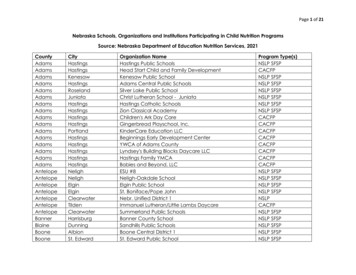
Transcription
Douglas Prasherwas driving a van for a cardealership in Huntsville,andRıseFall ofAlabama, when he learnedthat former colleagueshad won a Nobel Prize forthe research he began.TheBy YudhijitBhattacharjeeDouglasPrasherPhotographyby Miller MobleyIn December 2008 Douglas Prasher took a week off from his job driving a courtesy van at the Penney Toyota car dealership in Huntsville,Alabama, to attend the Nobel Prize ceremonies in Stockholm. It was the first vacation he and his wife, Gina, had taken in years. On the dayof the awards, he donned a rented copy of the penguin suit that all male Nobel attendees are required to wear, along with a pair of leathershoes that a Huntsville store had let him borrow. ¶ At the Nobel banquet, sitting beneath glittering chandeliers suspended from a seven-storyceiling, Prasher got his first sip of a dessert wine that he had dreamed of tasting for 30 years. When the waitress was done pouring it intohis glass, he asked if she could leave the bottle at the table. She couldn’t, she told him, because the staff planned to finish it later. His buddies back at Penney Toyota were going to love that story, he thought. ¶ Prasher’s trip would have been impossible without the sponsorship40DISCOVERDV0411PRASHER8A QG.indd 402/2/11 9:28 PM
DV0411PRASHER8A QG.indd 412/2/11 9:28 PM
of biologist Martin Chalfie and chemist andbiologist Roger Tsien, who not only invitedthe Prashers but paid for their airfare andhotel. Chalfie and Tsien, along with OsamaShimomura, an organic chemist and marinebiologist, had won the 2008 Nobel Prize inChemistry. The three researchers were sharing the 1.4 million award for the development of green fluorescent protein (gfp), amolecule that makes certain jellyfish glow.Starting in the mid-1990s, scientists beganusing gfp as a tracer for studying biochemical processes. The results were spectacular:The luminous protein made it possible toglimpse the inner workings of cells, tissues,and organs in unprecedented detail.Had life turned out slightly differently,Prasher could have been attending the ceremony not as a guest but as a laureate. Morethan two decades earlier, it was Prasherwho cloned the gene for gfp while working as a molecular biologist at Woods HoleOceanographic Institution in Massachusetts. The cloning was the first step in usinggfp as a tracer chemical in organisms otherthan jellyfish. Prasher proposed an experiment to see if the gfp gene could make bacteria glow, but he was not able to pull it off. In1992, when he was about to leave Woods Holefor another science job, he gave the gene to hiscolleagues Chalfie and Tsien. They went on toperform the experiments that made gfp andits variants into a powerful research tool, thefoundation of a multimillion-dollar industry.Prasher had the vision before anybodyelse did. But he failed to make it a reality.If gfp’s progression from an obscure protein into a biological laser pointer is a quintessential scientific success story, Prasher’sjourney from Woods Hole to Penney Toyotais a tale of individual and institutional failure. His vanishing act provides a glimpseinto what it takes to flourish in modern-dayscience, where mentorship, networking, andthe ability to secure funding can be as important as talent and intelligence.And then there is the role of luck. In lifeas in science, small underlying variables cantranslate into wildly divergent outcomes.One misplaced base pair in a dna sequencecan define the gap between health and disease. The paths leading to career success orfailure, too, can lie a hair’s breadth apart.at 58, douglas prasher sports a beardliberally flecked with gray. He’s six feet tall“Prasher’s vanishing actprovides a glimpse intowhat it takes to succeedin modern-day science.”with a paunch that invites a fair bit of ribbing from his teenage son. When I visitedhim at Penney Toyota on a hot and humidFriday afternoon, rows of new cars glintedunder the sun, festooned with balloons bobbing in the breeze. Prasher greeted me outside the dealership’s grubby-looking servicecenter, dressed in a blue golf shirt and khakipants—the company uniform. The courtesyvan was parked across from the entrance.Squinting through sunglasses and adjustinghis cap, he led me through a corridor to abody shop in the back where he introducedme to some of his colleagues. “They are allself-described rednecks,” he said with a laugh.Donny, a middle-aged man with a goatee and a golden locket, was bent over theheadlight of a car with an open hood. Hestood up and thrust his blackened pawout at me with a grin. “We’ve been teaching Douglas about the real world,” he said.Jim, another body shop worker, listed someof the things they had educated Prasherabout. They all happened to be local culinary delights: “mountain oysters” (hogs’ testicles), fried moon pies, Goo Goo Clusters. Iasked Jim if Prasher had taught them anything in return—say, about dna. “dn who?”Jim asked, smiling. The comment evoked achortle from Prasher, whose typical mannercombines irony and earthiness.Prasher was born into a working-classfamily in Akron, Ohio, where his father andmaternal grandfather worked at the Goodyear tire factory. He too worked at the factoryfor a summer during college; the experiencewas enough for him to realize that he wasnot cut out for a blue-collar job. He ended upearning a Ph.D. in biochemistry from OhioState University, guided by nothing morethan a general interest in the life sciences. “Ididn’t know what else to study,” he told me.After Prasher got his doctorate in 1979, hewent to work as a postdoc at the Universityof Georgia in Athens, learning how to clonegenes and get them to switch on inside bacteria. It was at the university that he methis future wife, Gina Eckenrode, a Ph.D. student in biochemistry who was drawn to hiskindness and wry sense of humor, whichwas less cynical back then. One day when hewas in the lab, she sent him a “gorillagram”—alove letter delivered by a person in a gorillasuit. Prasher still feels embarrassed when herecalls the moment. While at Georgia, healso met Milton Cormier, a biochemistryprofessor who was studying bioluminescence,the ability of certain organisms to produceand emit light. Through Cormier, Prasherlearned about a species of jellyfish living inthe cold waters of the North Pacific, Aequorea victoria, which emitted a green glowand was one of the most intensely bioluminescent creatures on the planet.The fundamental chemistry behind thecreature’s glow had been worked out by Shimomura and others in the 1960s. The jellyfish is shaped like an umbrella, and its lightcomes from a ring of tiny, stemlike extensions along the umbrella’s circumference.Studying liquid squeezed out from theseluminescent organs, Shimomura identifiedtwo proteins—called aequorin and gfp—that worked together to emit light. Aequorin gives out blue light when it binds withcalcium in seawater; this light is absorbed by42DISCOVERDV0411PRASHER8A QG.indd 422/2/11 9:28 PM
gfp, which then emits an intense green glow.Cormier had a grant from pharmaceutical giant Hoffmann–La Roche to clone thegene for aequorin. The company wanted touse it as a diagnostic marker for disease: Ifsynthetic versions of antibodies could betagged with aequorin in the lab, then whenever they matched up with an antigen (orsurface protein) of a specific pathogen inblood or tissue, the sample would glow. Theonly way to make aequorin on a commercial scale, Cormier believed, was to cultivate it inside bacteria that had been genetically engineered to contain the aequoringene. But first he needed copies of the gene;it had to be cloned. To do the cloning, hehired Prasher, who quickly became fascinated by bioluminescence.Soon prasher was travelingto the town of Friday Harbor,on an island in Puget Sound, tocatch jellyfish by the thousands asthey floated past the docks. Aftercatching the jellyfish with pool-skimmingnets, he and a group of other scientistswould pin them down with a fork and spinthem across a razor’s edge to slice off thelight-emitting photo-organs, which wouldfall into a bucket in a translucent linguiniheap. It was exhausting work that Prasherdived into with esprit de corps. Once theteam members harvested the photo-organs,they were distributed like tomatoes from acommunity garden.Prasher would freeze some of this tissueright away to take back to his lab to extractdna. Other scientists would process the sametissue further to obtain the light-emittingproteins. They would add a liter of the tissueto two liters of seawater and shake the mixture 75 times—no more, no less—to make“the individual light-producing cells popout of the tissue,” according to Bill Ward,a bioluminescence researcher at RutgersUniversity in New Jersey who was a postdoc in Cormier’s laboratory. The cells werefiltered through mosquito netting and putthrough another series of steps to deriveaequorin and gfp.Over the course of six months, Prasherbuilt libraries of jellyfish genes from the tissue he collected. Every tissue in an organismcontains a variety of messenger rna molecules, single-stranded nucleotide sequencesbearing instructions for the making of specificproteins. Since messenger rna is nothingbut the imprint of the gene whose messageit is carrying, it is possible to use it to chemically generate the dna sequence or gene itcorresponds to. From the sizable collectionof genes generated this way, Prasher hopedto identify the specific ones responsible foraequorin and gfp.To search through his gene library, Prasherrelied on work done by Ward and others,who had already partially determined thesequence of amino acids (units of a protein)of which the bioluminescent moleculeswere made. Working backward, Prashercreated synthetic dna molecules that wereapproximate blueprints of the actual genes.He tagged each artificial gene with a radioactive compound and then added it to amixture of E. coli containing most of thegenes extracted from the jellyfish.As he had hoped, his synthetic genes andthe real ones were similar enough for thedna base pairs to stick together. Both theaequorin and gfp genes were now identified, but Prasher felt that just one—thegene for gfp—was biomedical gold. Mostlight-emitting proteins found in naturedo not work alone. Instead they rely on achromophore, a light-producing chemicalunit that is analogous to the filament ofa bulb. Through a complicated biochemical process, the chromophore is added onto the protein, generating light. Aequorinwas like that, able to light up only with thehelp of its chromophore, a property scientists today call bioluminescence. gfp, however, could stand alone. Scientists calledit fluorescent rather than bioluminescentbecause a chromophore was never neededto produce the light.Prasher immediately grasped the importance of his discovery. As a single-unit lightsource, gfp could serve as a perfect molecular tag for tracking genes and proteins in anorganism. If a biomolecule of interest weretagged with the gfp gene, Prasher thought,a fluorescent signal would show when andwhere in the organism that gene or the protein it created was being put to use. “I knewgfp could be incredibly useful because itwould be much easier to use in living systems than what was available,” he said.All the signs looked promising for Prasherin 1987 when he got a tenure-track job atWoods Hole. He and Gina bought a housethat was an eight-minute drive from thebeach in the nearby town of Falmouth. Thecouple had a young daughter, Emma, and,for the most part, Gina stayed home toraise her. Money was always tight, but thefamily got by. Prasher, who likes gardening,planted vegetables in the backyard. “We’dcollect seaweed from the beach to put onthe asparagus bed,” Gina said. “We grewtomatoes to make spaghetti sauce.”Prasher soon received a 200,000 grantfrom the American Cancer Society to clonehis synthetic gene. But he hit a brick wall atthe National Institutes of Health and elsewhere as he tried to fund research provingthe cloned gene worked in other organisms.“It was a high-risk idea,” he told me. Manyscientists in the field, including Ward andShimomura, still doubted that only onegene was involved or that gfp could beexpressed in organisms other than jellyfish.as prasher describes it, his time atWoods Hole was a series of missed connections, psychological roadblocks, andbad breaks. He was one of only a handful ofmolecular biologists in a department populated by marine biologists and ecologists.“Very few people cared about what I wasdoing,” Prasher says. One day in 1989, hegot a call from biologist Martin Chalfie atColumbia, who had heard about Prasher’sattempts to clone the gfp gene. To Chalfie,the fluorescent molecule was a potentialtool to help him investigate the sense oftouch in roundworms and to explore morebroadly how organisms react to stimuli. LikePrasher, he also realized that gfp tags couldprovide a way to track the production ofgenes and proteins writ large. Prasher promised that he would get in touch with Chalfieonce he had cloned the synthetic gene.More than a year later, when Prasher finished cloning the gene, he called Chalfie’slab only to learn that the researcher wason sabbatical at the University of Utah.Prasher says he left voice mail for Chalfiein Utah but never heard back; Chalfie doesnot recall getting any messages from him.Regardless, it wasn’t until September 1992that Chalfie, now back at his Columbia lab,pushed forward with his gfp research. Helamented to a graduate student that he hadnever heard from Prasher; then a search ona computer database turned up a recentpaper by Prasher reporting the cloning ofthe synthetic gfp gene. Within minutes,4304.2011DV0411PRASHER8B4 QG 432/4/11 3:38 PM
“He was so depressed bythe lack of support that hisdaughter remarked, ‘Papadoesn’t smile anymore.’ ”Chalfie had Prasher on the phone.Chalfie’s call could have been a scientific lifeline for Prasher, but it came too late.Doubtful that he would be granted tenure,Prasher had already made up his mind to quitWoods Hole. A seminar he had given at thedepartment earlier that year had not gonewell. He had gotten so depressed by the lackof funding and mentorship that his daughter,Emma, who was 3 at the time, remarked oneday to Gina, “Papa doesn’t smile anymore.”The next day, Prasher told the tenure committee to stop the review process and gavehimself a year to find another job.“I just didn’t fit,” he said. “I was so isolated.” He was convinced that he wouldstruggle even if he did get tenure; he didnot have the strength to do his research insolitude when so few cared about his work.“Doug doesn’t have the ‘Goddammit, you’renot going to stop me’ attitude,” Ward says.“He’s the kind of person who really neededa facilitator-type person or organization tosay, ‘Look, I think you’re doing a great job.’ ”Along with withdrawing from the tenureprocess, Prasher decided to quit workingon gfp. “The area of bioluminescence wasesoteric work; nobody was interested, andfunding was very difficult,” he says. “I didn’twant to have to struggle to find funding forsomething that was so difficult to convinceother people to support.” He decided to passalong his research to the few who seemedto understand it. A few days after Chalfie’scall, Prasher drove to the post office with alittle tube containing the gfp gene, put it ina padded envelope, and mailed it to Columbia. He also sent a sample to Roger Tsien atthe University of California, San Diego, who,like Chalfie, had seen Prasher’s paper andcontacted him. “He asked me if he couldhave the gene; I immediately said yes,”Prasher told me. “I remember he soundedvery surprised.”leaving the post office, prasher felta wave of sadness. “I knew this was reallythe end of it for me,” he said. But passing thebaton seemed like the only sensible option.Chalfie and Tsien had “resources waybeyond mine, by orders of magnitude. Theywere both at hard-money institutions, and Iwas struggling to get funding. I didn’t havegraduate students, didn’t have postdocs.”Chalfie had another advantage. He didnot have to apply for a grant specificallyto experiment with the gfp clone; he wasable to do the work as part of his project ontouch sensitivity in roundworms. Within amonth of receiving the gene, his group wasable to make E. coli glow green. Chalfie’s labdid not own a fluorescence microscope andneeded to monitor the results; he solved theproblem in part by asking microscope salesmen to bring in demo models, which his labhastily used for real experiments. It was thekind of resourcefulness that Prasher seemedto lack. Shortly afterward, Chalfie and hiscolleagues succeeded in inserting the gfpgene into the roundworm, making touchreceptor cells fluoresce. The experimentsconfirmed that the gfp gene could make anorganism light up without the need for anyother molecules unique to jellyfish.Tsien’s lab, meanwhile, tinkered withthe gfp gene to see if it could be made toproduce light in any other colors. By designing mutant versions of the gene that theyreceived from Prasher, Tsien and his colleagues were able to make variants of gfpthat glowed blue, cyan, and yellow, as wellas a brighter green than the original gfp.The glowing roundworm from Chalfie’slab made the cover of Science in 1994.Prasher was one of the coauthors on thepaper, now considered a landmark publication that helped establish gfp as a powerfulresearch tool. The paper would undoubtedly have boosted his chances of tenure atWoods Hole, but by the time it appeared, hehad taken a job at a research center of theU.S. Department of Agriculture down thestreet, working on molecular detection ofexotic agricultural pests. “My frank assessment is that history would be quite different if Douglas and I hadn’t lost track of eachother,” Chalfie told me recently. “If we haddone the experiment a few years earlier, hemight have stayed at Woods Hole.”The Science paper sparked a surge ofinterest in gfp. Prasher received dozensof requests for the gene from around theworld. Although he had quit the field, heresponded to every scientist who contactedhim, initially sending out copies of the genehimself and later forwarding the requests toColumbia. Prasher and Chalfie were awarded a patent for the use of gfp as a marker ofgene expression; in total, it earned Prasherjust a few hundred thousand dollars in royalties over 15 years.The money helped, but it was no substitute for a stable scientific career. After threeyears at the usda center in Massachusetts,Prasher was transferred to Beltsville, Maryland, forcing a move that was painful for hisfamily. “We were in the middle of the schoolyear,” he told me. “It was rough.” Prasher didnot get along with his new boss and foundhimself slipping into depression. But heplodded on.In the summer of 2004, Prasher got anew job with A.Z. Technologies, a nasa contractor in Huntsville. His assignment wasdeveloping sensors to detect microbes in aspacecraft cabin during long flights. His family moved to Alabama with him. Prasher likedthe work, especially because he was finallygetting to collaborate in a team environment after years without it. But the unpredictable nature of science funding struckagain. A year and a half later, A.Z. Technolo-44DISCOVERDV0411PRASHER8A QG.indd 442/2/11 9:28 PM
gies learned it would be losing funding forthe project because of a decision by nasato reduce support for life sciences. Prasherwas laid off in the spring of 2006, and afternearly a year of unemployment—Huntsvilleis not exactly a biotechnology hub—he tookthe driving job at Penney Toyota.On the morning of October 8, 2008, as hewas fixing breakfast, Prasher heard newsof the Nobel on the kitchen radio. His firstreaction was to call the local radio stationto tell them to correct the newscaster’s pronunciation of “Tsien.” Then he put on hisPenney uniform, went in to work, and tookhis regular place behind the wheel of thecourtesy shuttle.after the landmark experiments with thegfp gene in the mid-1990s, “all of a suddenit became obvious that gfp was a wonderful tool,” Chalfie says. With gfp, though, aswith many scientific breakthroughs, the tremendous importance of the discovery wasnot clear until many years after the initialwork. Over the past 15 years, the gfp genehas enabled scientists to watch a plethoraof previously murky biological processes inaction: how nerve cells develop in the brain,how insulin-producing beta cells form inthe pancreas of an embryo, how proteinsare transported within cells, and how cancer cells metastasize through the body. In apress release announcing the 2008 chemistry prize, the Nobel Foundation called gfp“a guiding star for biochemistry.”The glow of the gfp gene may have illuminated biology, but Prasher has remainedin the shadows. Today he and Gina liveon a quiet block in northwest Huntsville,about three miles from the Toyota dealership. In the backyard is a small vegetablepatch; the day I arrived, Prasher excused4504.2011DV0411PRASHER8A QG.indd 452/2/11 9:28 PM
himself in mid-conversation to check on “agroundhog problem” that had been plaguing his tomatoes. Walking into the house,I was struck by the handsomely furnishedinterior, including two ovens and two dishwashers; it didn’t look like it was owned bya courtesy van driver making about 300 aweek. I learned that the Prashers had begunbuilding the house while Douglas was stillworking at A.Z. Technologies. They endedup using much of their savings to finishconstruction and were now using it to paytheir monthly bills.When he heard the announcement of the2008 chemistry Nobel, Prasher felt angryand disappointed, not because he hadmissed out on the prize but because he was“out of science and out of a job” that paidenough. In media interviews days after theprize was announced, he jokingly said thathe was accepting donations. A few checksdid come in from sympathizers, including 1,000 from a lady whom Prasher haddriven in his van. Prasher put a sticker onthe back of his own car that said “Scientistneeds work” and listed his phone number.He removed it only when Karl, his teenageson, made a fuss.On the second morning of my visit, during which I stayed at Prasher’s house, I woketo find my host padding about the kitchenin sweatpants. He was making a semolinaporridge that he and Gina had first triedat the breakfast bar of the Grand Hotel inStockholm, during his Nobel trip. A booktitled Winning the Games Scientists Play layon the kitchen counter next to a framed clipfrom The Huntsville Times headlined “LocalScientist Misses Nobel.”The attention brought by the Nobel Prizeleft Prasher in a strange emotional place:pleased that his work had not been in vain,yet sullen about the way things had turnedout for him. Despite his flippant requestfor donations, he seemed inclined to rebuffany pity with scorn. After the Nobel ceremonies, Tsien asked Prasher if he wouldbe interested in joining his lab at ucsd.Prasher declined. It felt like a handout, hetold me; people would say, “Douglas can’tgo anyplace else, so Roger’s picking him up.”Another reason, he said, was that he wanted to distance himself from gfp. “That’s inmy past. That’s over,” he said, as if the protein were an addiction he was intent on ridding from his life.46DISCOVERDV0411PRASHER8A QG.indd 462/2/11 9:28 PM
An aura of “what if” hangsover Prasher’s career. “I don’tknow why Douglas didn’t gethelp from his former mentor,Milton Cormier,” Tsien says.Cormier, now retired, told me he “had no ideathat Doug had given the gfp gene to Rogeror Martin and that he had left Woods Holeuntil it was all over. This was too bad; if Doughad confided in me, I could have gotten hima position in the pharmaceutical industry.”What about reaching out to scientists atWoods Hole, particularly Shimomura, whosework overlapped his own? “It never occurredto me,” Prasher says, betraying what seemedlike ignorance of the need to network in anyfield, especially science. “He kept to himselfand I kept to myself.” It seemed like a strangestance for somebody who didn’t want to workin isolation. I also wondered if Prasher couldhave sought help from some of the scientistswho contacted him for the gfp clone. “Hedoesn’t like asking for favors,” Gina told me.One of Prasher’s interests is Civil War reenactments, and from his perch in 2011, he imagines a reenactment of his early career: If onlyhe had networked with other scientists andinstitutions, especially when he felt isolated,he says today, he might have stayed in thefield of bioluminescence or at least in science.Many of the challenges Prasher faced werehardly unique to him. Scientific opportunitiesoften appear only at specific times and places,potentially a serious impediment for a parentwho doesn’t want to relocate the family. Doyour work in the wrong place, or publish it inthe wrong journal, and it may vanish withouta trace. And once someone drops out of science, it is hard to get back in. After joiningthe Toyota dealership, Prasher applied for acouple of science-related jobs in Huntsville,but nothing worked out. On one occasion hehad an encouraging meeting with the hiring manager at a local company working onmicrofluidics; when the interviewer learnedthat Prasher drove a courtesy van, his interest cooled. There is no way to know howmany other potential researchers were drivenfrom their studies for similar reasons, or howmany potential discoveries were never madebecause of the psychological and practical difficulties of the scientific lifestyle.Finally in June 2010, several weeks aftermy visit, Prasher’s luck changed. He e-mailedme to say he’d been offered a science job atStreamline Automation, a local research anddevelopment company. Staffed by about 20people, the company does work for nasa, theNational Science Foundation, and the U.S.Department of Defense. Prasher’s first taskwhen he started in late June was to help develop technology to sense toxic industrial gases.He began cautiously. “There was none of thetremendous relief you might expect,” he says.“I had been so discouraged over the years thatmy attitude was, this may work out and it maynot.” Gradually he settled into the job. Athome he occasionally took science readingto bed, something he hadn’t done in years.“A lot of the hangdog is gone,” Gina told me.In December Prasher won a six-month, 70,000 grant from the Department ofDefense to develop a field technique for categorizing tick specimens according to theirmitochondrial genes, in hopes of limiting thediseases a doctor might diagnose. It broughta sense of accomplishment that had beenmissing from his life for a long time. In January he told me that the cloud of depressionhe had lived under for years was finally lifting. Science gave him a sense of purpose.Still, there were things about Penney Toyotathat he would remember fondly, he told me:the time he spent with his buddies in the bodyshop, their amusement when he showed up forhis first day of work dressed in suspenders, theendless teasing about Prasher’s liberal viewsas they watched Fox News around the clock,the question one of them asked when Prasherwas about to slice open a kiwi at lunch: “Areyou going to eat that fuzzy potater?” Thesecolleagues had broadened Prasher’s definitionof expertise. “Even though these people are notin a glamorous position, they are incrediblyknowledgeable about what they do,” he says.In our most recent conversation, Prashertold me he was busy reading up on a newtechnique he could apply to the detection offood allergens. “One thing I’ve always enjoyedis browsing the literature,” he says, notingthat he prefers thumbing through journals todoing keyword searches because it allows himto discover concepts he hadn’t known aboutbefore. For several years, he notes wryly, “therewas very little motivation to do that.”Now there was, a reason to step back into aworld of inquiry where the pursuit of an exciting idea is its own reward. After an untimelyand seemingly permanent exit from science,Douglas Prasher has made his way back in, apersonal triumph no less meaningful to himthan a Nobel Prize.4704.2011DV0411PRASHER8A QG.indd 472/2/11 9:28 PM
Prasher by Miller Mobley Douglas Douglas Prasher was driving a van for a car dealership in Huntsville, Alabama, when he learned that former colleagues had won a Nobel Prize for the research he began. In December Douglas Prasher took a week o from his job driving a courtesy van at the Penney Toyota car dealership in Huntsville,










